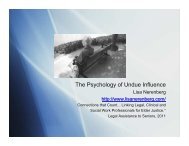Undue Influence: Definitions and Applications - California Courts ...
Undue Influence: Definitions and Applications - California Courts ...
Undue Influence: Definitions and Applications - California Courts ...
You also want an ePaper? Increase the reach of your titles
YUMPU automatically turns print PDFs into web optimized ePapers that Google loves.
financial gain. Others have focused on specific vulnerabilities, such as the role of subtle,<br />
undetected deficits that appear to heighten vulnerability.<br />
Several experts have proposed broader models or constellations of contributing factors<br />
including victim vulnerabilities, abuser characteristics, tactics used, <strong>and</strong> outcomes. Psychiatrist<br />
Bennett Blum has developed the “IDEAL” model of undue influence assessments (Blum, 2010).<br />
The model draws from the fields of psychiatry, psychology, <strong>and</strong> sociology to describe<br />
psychological <strong>and</strong> social factors that commonly coexist in undue influence. IDEAL is an<br />
acronym for isolation; dependency; emotional manipulation <strong>and</strong>/or exploitation of a<br />
vulnerability; acquiescence; <strong>and</strong> loss. Blum further describes the factors as follows:<br />
1. Isolation – This refers to isolation from pertinent information, friends, relatives, <strong>and</strong><br />
usual advisors. Causes include medical disorders, a history of poor relationships<br />
with others, perpetrator interference, geographic changes (e.g., travel), <strong>and</strong><br />
technological isolation (e.g., loss of telephone services).<br />
2. Dependency – This refers to dependence upon the perpetrator for physical support,<br />
emotional factors, or information.<br />
3. Emotional manipulation – This usually manifests as promises, threats, or a<br />
combination of both regarding issues of safety <strong>and</strong> security, or companionship <strong>and</strong><br />
friendship. Exploitation of a vulnerability may overlap with emotional manipulation<br />
4. Acquiescence – The victim appears to consent or submit, but does so because of<br />
items 1, 2, <strong>and</strong> 3.<br />
5. Loss – This refers to actual financial loss.<br />
Turkat, an attorney, drew from social influence theories to describe characteristics of the<br />
influencers, victims, <strong>and</strong> the forms of control he has observed in elder abuse cases. In particular,<br />
he focused on power imbalances between abusers <strong>and</strong> victims that are derived from character<br />
traits, intelligence, strength, social class, <strong>and</strong> education. He further suggests that these power<br />
imbalances can be magnified by “vulnerability enhancements,” which include:<br />
• Increasing victims’ dependency by giving them extra medications or depriving them of<br />
nutrients;<br />
• Self-promotion;<br />
90




